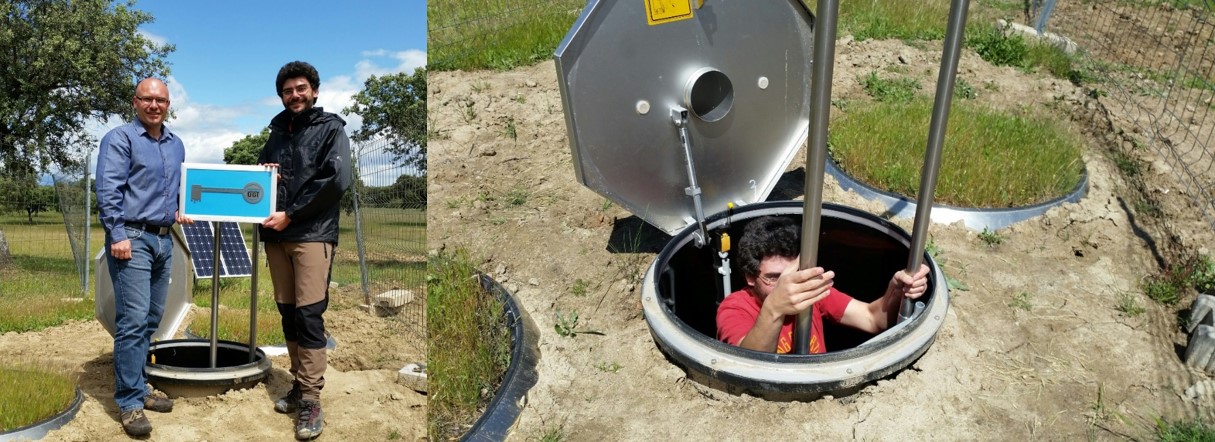Title
MaNiP – A large scale nutrition manipulation experiment
Who
The Large-Scale Manipulation Experiment (MANIP) project is a collaboration between the Research Groups “Soil Biogeochemistry” and “Biosphere-Atmosphere Interactions and Experimentation” of the Department Biogeochemical Integration at the Max Planck Institute for Biogeochemistry. This project is led and coordinated by Mirco Migliavacca.
Introduction to MANIP
The overall aim: of the project is to study long-term effects of nitrogen and phosphorus addition to a Spanish Dehesa system on ecosystem carbon, water and energy fluxes, and phenology
Background: Mixed tree-grass systems are widely distributed (~16-35% of global land-surface) vegetation formations such as tropical and Mediterranean savannas, the “waldsteppe” in Eurasia and culturally influenced vegetation types such as agro-forestry systems or grazed open-forests in Europe (Hill, Hanan et al. 2011). Semi-arid tree-grass systems are considered one of the major contributors to the interannual variability of the global carbon cycle (Poulter, Frank et al. 2014). Despite their wide distribution, Earth observation systems, and associated land-surface modeling development have been so far poorly adapted to the key structural and functional characteristics of tree-grass ecosystems. As consequence a significant uncertainty and bias in the assessments of energy, carbon, water and biogeochemical dynamics is often observed (Hill, Hanan et al. 2011)
MaNiP project offers an original experimental design integrating cutting-edge approaches (including eddy covariance, lysimiters and hyperspectral; remote sensing) to study the combined effect of nutrient and water limiting factors on fundamental ecosystem, plant and soil processes.
Sub-Projekt: of Manip was to evaluate the underlying causes of differences between latent heat (LE) fluxes measured with two enclosed-path eddy covariance systems (EC) at two measurement levels and independent estimates. Estimates of LE by replicated weighable tension-controlled lysimiters (LELys) (Fig. 1 and 2) provided a robust baseline to compare EC LE measured at 1.6 m above ground (LE1.6). Similarly and at the ecosystem level, LE up-scaled using independent measurements (LEupscaled= sap flow + lysimeter) was benchmarked with LE measured by a EC tower at 15 m above ground (LE15) (Perez-Priego, El-Madany et al. 2017).
 Fig. 1 Weighable tension-controlled lysimiters (LELys) produced by Umwelt-Geräte-Technik GmbH, Germany
Fig. 1 Weighable tension-controlled lysimiters (LELys) produced by Umwelt-Geräte-Technik GmbH, Germany
Material and Methods
This study was carried out in a Mediterranean tree grass savannah in Spain (39°56´24.” N, 5° 45´50.27” W; Majadas de Tietar, Caceres) for one year (2015). Two Eddy covariance towers were established (EC1.6 and EC15). Additional three hermetically sealed polyethylene-high-density container stations were installed underground within the fetch of the tall Eddy Covariance tower. Each station contained 2 weighable lysimeters of the temperature- and tension-controlled type (Reth, Seyfarth et al. 2007). The pressure inside the tank is adjusted according to the current soil matrix tension measured by a reference tensiometer (tensio 160, Umwelt-Geräte Technik GmbH). Soil moisture and temperature (UMP-1, Umwelt-Geräte-Technik GmbH, Germany) at 10, 30, 75 and 100 cm were measured inside each lysimeter. Water seepage was measured with a tipping counter (VKWA 100, Tipping counter, Umwelt-Geräte-Technik GmbH, Germany). Tree transpiration was estimated by the heat ratio method (SFM1 Sap Flow Meter, ICT International) in six trees within the foodprint of the tall EC tower (Fig. 3).


Results and Conclusion
Results underestimation of LE1.6 (up to 35%) compared to LELys, which mostly occurred during the growing season. revealed substantial However those differences were remarkably lower when likening LE15 versus LEupscaled (14%) suggesting that the dampening of the water vapor fluctuations due to low-pass filtering effects is more pronounced near the surface (see Fig. 4). (Perez-Priego, El-Madany et al. 2017)
 Fig. 3. Diurnal time course of half-hourly values of understory latent heat (LE) fluxes by eddy covariance (EC) and lysimeter, net radiation (Rnet), and flux storage (LEstorage)for two-week periods in spring (Fig. 3a, c) and one week during the dry season (Fig. 3e). Filled circles represent low-quality data for EC. Respective mean diurnal variationsand the friction velocity (u*) are also presented (Fig. 3b, d, f). Shade areas in LELysrepresent the error computed from the 6 lysimeter stations. (Perez-Priego, El-Madany et al. 2017)
Fig. 3. Diurnal time course of half-hourly values of understory latent heat (LE) fluxes by eddy covariance (EC) and lysimeter, net radiation (Rnet), and flux storage (LEstorage)for two-week periods in spring (Fig. 3a, c) and one week during the dry season (Fig. 3e). Filled circles represent low-quality data for EC. Respective mean diurnal variationsand the friction velocity (u*) are also presented (Fig. 3b, d, f). Shade areas in LELysrepresent the error computed from the 6 lysimeter stations. (Perez-Priego, El-Madany et al. 2017)
For more details please see:
https://www.bgc-jena.mpg.de/bgi/index.php/Research/ManipProject